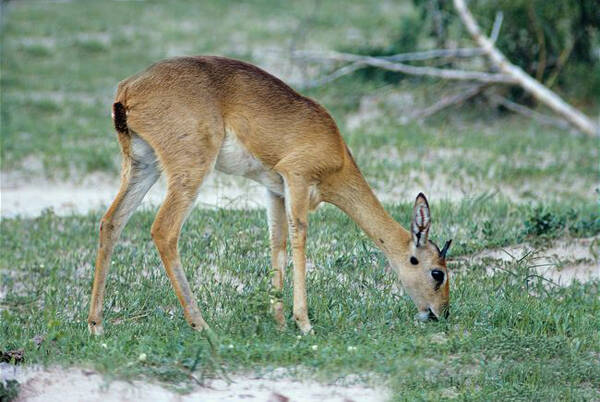Ourebia ourebia
IUCN
LCBasic Information
Scientific classification
- name:Ourebia ourebia
- Scientific Name:Ourebia ourebia
- Outline:Ungulata
- Family:Artiodactyla Bovidae Oyster
Vital signs
- length:92-140cm
- Weight:14-21kg
- lifetime:No verification information
Feature
There is a line of white fur above the eyes and a bald black hairless patch under the ears
Distribution and Habitat
Origin: Angola, Benin, Botswana, Burkina Faso, Cameroon, Central African Republic, Chad, Democratic Republic of Congo, Côte d'Ivoire, Eritrea, Ethiopia, Gambia, Ghana, Guinea, Guinea-Bissau, Kenya, Lesotho, Malawi, Mali, Mozambique, Niger, Nigeria, Rwanda, Senegal, Sierra Leone, Somalia, South Africa, South Sudan, Sudan, Swaziland, United Republic of Tanzania, Togo, Uganda, Zambia, Zimbabwe.
Possibly extinct: Burundi. Regionally extinct: Tunisia.
Lives in grasslands south of the Sahara Desert. Inhabits open grasslands, preferring habitats with short grasses interspersed with tall grasses to hide in.
Appearance
The head and body length of the oryx is 92-140 cm, the shoulder height is 50-70 cm, and the weight is 14-21 kg. It is a medium-sized ungulate and the smallest antelope in the subfamily of antelopes. The male has slender pointed horns, a graceful body, a long neck, large ears, slender legs, and a short and fluffy tail. The fur is soft and shiny, with light yellow to reddish brown fur on the back of the body and white on the belly. There is a long tuft of hair on each knee, and the tail is short and black with white at the bottom. There is a white line of fur above the eyes, which can often be used to help distinguish them from other ungulates. There is a bald black hairless patch under the ear, and a tuft of long hair on each knee. On both sides of the face are vertical creases that house preorbital glands. These glands produce a scented secretion used to mark the ory of the oryx.
Strong physique; with legs suitable for long-distance running; there are 4 toes on the feet, but the lat
Details
Orebia ourebia (scientific name: Ourebia ) is called Oribi in foreign language. It has 9 subspecies and is a medium-sized ungulate.

Orebia usually live in pairs or small groups of up to 7. There is one adult male and up to three adult females in a group. These groups have their own territories, which are marked and demarcated with urine, feces, and secretions from the preorbital glands. Active during the day. Eat fresh grass in the rainy season and shrubs in drought. Licking minerals every few days to supplement the salt in the diet.
If the oryx is threatened by a predator, the oryx will hide in the tall grass within a few meters of the predator. As they move through the grass and jump, the underside of their tail will flash white fur as a warning to other oryx. When panicked, oryxes will also make a piercing whistle. When threatened, they will jump vertically upwards with all four legs straight and their backs arched, which is called "stotting".
Although oryx may give birth throughout the year, the breeding season is mainly in the rainy season, when food is abundant and the ground vegetation and grass cover are lush. After a gestation period of 200-210 days, the baby oryx is born. Male oryx reach sexual maturity within 14 months, while females can become pregnant and give birth after 10 months.
The oryx has a wide distribution range and is not close to the critical value of vulnerable and endangered species survival (distribution area or fluctuation range less than 20,000 square kilometers, habitat quality, population size, and distribution area fragmentation). The population trend is stable, so it is evaluated as a species without survival crisis.
Listed in the 2016 IUCN Red List of Threatened Species ver 3.1 - Least Concern (LC).
Protect wild animals and eliminate game.
Maintaining ecological balance is everyone's responsibility!








